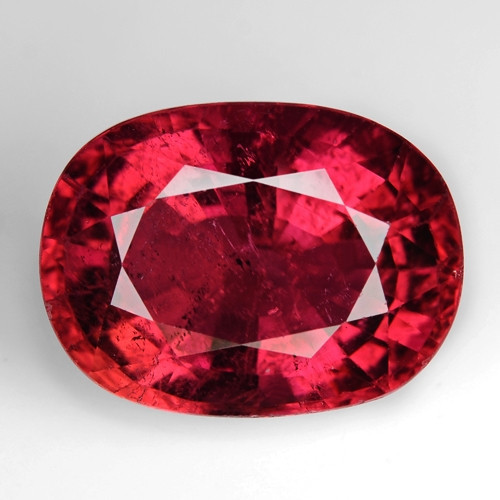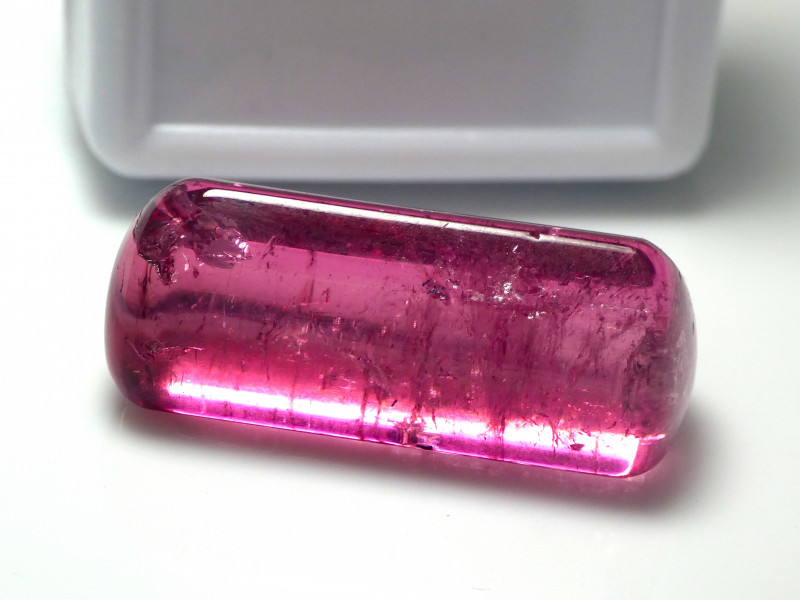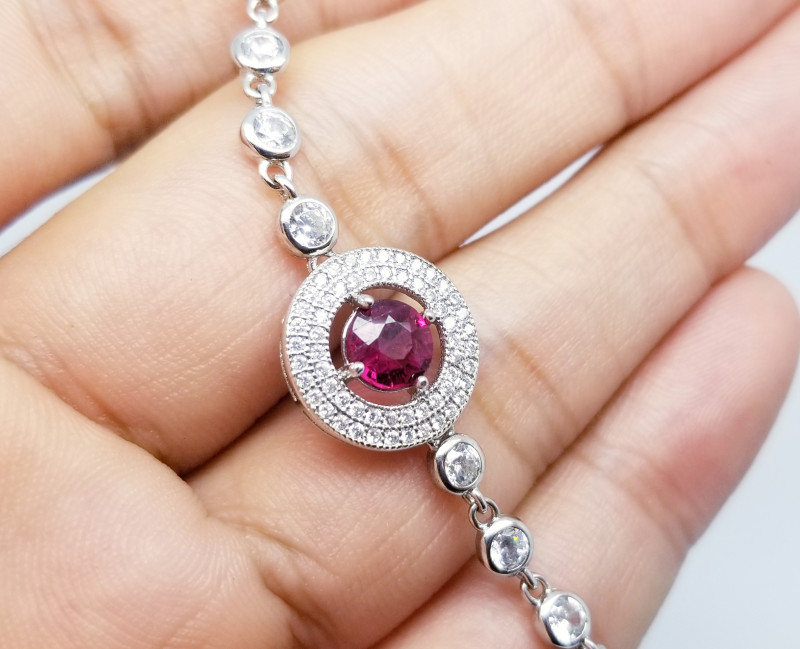
Rubelit turmalin: značenje, cijena i prednosti
 Rubelit je rijetka i tražena vrsta turmalina , dragog kamenja , s romantičnim crvenim i ružičastim nijansama. Kristal turmalina često se povezuje s rubinima, iako su to različiti dragulji.
Rubelit je rijetka i tražena vrsta turmalina , dragog kamenja , s romantičnim crvenim i ružičastim nijansama. Kristal turmalina često se povezuje s rubinima, iako su to različiti dragulji.
Jesu li ružičasti turmalin i rubelit ista stvar? Odgovori se razlikuju, ali većina bi rekla da je „ružičasti turmalin“ drugi naziv za rubelit. Međutim, neke rijetke ružičaste nijanse pojavljuju se i u drugim varijantama turmalina.
Bez obzira na to, rubelit je poznat po svojim crvenim nijansama. Ali jeste li znali da je crvena najrjeđa boja dragog kamenja? Rubelit se pridružuje rubinu i crvenom spinelu kao jedini dragulji s tako čistom, bujnom, tamnocrvenom bojom, što samo doprinosi privlačnosti rubelita.
Već se osjećate zaluđeni? Ostanite s nama kako biste saznali više o svojstvima rubelit turmalina, značenjima, cijenama i još mnogo toga!

Što je rubelit turmalin?
Rubelit je poludragi kamen , iako dijeli slične nijanse i etimologiju s dragim kamenom rubinom .
Kad smo već kod imena, rubelit se može pisati kao rubelit ili rubilit. Ostali nadimci uključuju apirit, afrit i crveni šorl, iako je crveni šorl češće sinonim za rutil.
Kao turmalin, rubelit je kamen rođenja u listopadu , kamen zodijaka Vage i dragulj za 8. godišnjicu braka . Rubelit posebno obilježava 5. godišnjicu i zvjezdani je kamen za sunce.
Sličnost kristala s rubinom čini ga pristupačnijom zamjenom za rubin - bilo da je to rođendanski kamen u srpnju ili poklon za 40. godišnjicu braka.
Što se tiče te teme, razjasnimo svaku zabunu između rubina i rubelita.
 Na gornjoj slici: Ruby
Na gornjoj slici: Ruby
Rubelit u odnosu na rubin
Rubelit se povijesno zamijenio za rubin. Ta dva kamena imaju sličnosti - crvene do ružičaste boje, imena koja odražavaju te boje i izvrsnu nosivost. Ali to je otprilike sve što se tiče sličnosti.
Za razliku od turmalina rubelita, rubin je dragi kamen korund . Iako oba kamena potječu odavno, rubin ima značajnije mjesto kroz povijest.
Što se tiče cijene, je li rubelit skuplji od rubina? Ne, upravo je suprotno.
Njihova mineralna svojstva se također razlikuju. Rubini imaju 9. ocjenu na Mohsovoj ljestvici tvrdoće , dok rubeliti imaju ocjenu od 7 do 7,5.
Vrste inkluzija u oba kamena dovoljno su različite za identifikaciju. Dok su rubini poznati po svojim "svilenim" inkluzijama igličastog rutila , rubeliti su poznati po fluidnim inkluzijama koje mogu formirati niti nalik uvojcima ili mrežama zvanim "trihiti".
Razrađujući mineralogiju, sljedeće ćemo se detaljnije pozabaviti mineralnim karakteristikama rubelita.
Specifikacije i karakteristike rubelita
Mineral rubelit spada u seriju turmalina elbait, skupinu natrij-aluminij-litijevih borosilikata. Elbaiti su najšarenija skupina i sadrže najviše varijanti draguljarske kvalitete. Ostali elbaitni turmalini uključuju indikolit , paraiba turmalin i kromov turmalin .
U nekim slučajevima, neki rubeliti se mogu klasificirati kao liddikoatit - rijetka serija slična elbaitu, ali s kalcijem umjesto natrija - ili olenit - serija s visokim udjelom aluminija koja tvori seriju sa schorlom (crnim turmalinom) i elbaitom. Međutim, većina rubelita su elbaitni turmalini.
Kao što je gore spomenuto, neki gemolozi razlikuju ružičasti turmalin od rubelita. Općenito, navodna razlika između rubelita i ružičastog turmalina je u tome što je boja rubelita mnogo zasićenija.
Osim toga, neki tvrde da se "rubelit" odnosi samo na crvene turmaline koji zadržavaju crvenu boju pod različitim vrstama osvjetljenja.
U nastavku su navedena preostala svojstva rubelita:
Mohsova tvrdoća : 7-7,5
Boja : Uglavnom zasićene nijanse crvene, ružičaste; Može biti ljubičasto-crvena, smeđe-crvena, narančasto-crvena
Kristalna struktura : heksagonalna (trigonalna)
Sjaj : Staklasto (staklasto)
Prozirnost : Prozirna do neprozirna
Indeks loma : 1,619-1,655
Gustoća : 3,01-3,06
Dekolte : Nema
Prijelom : Konhoidan ili neravan/nepravilan
Pruga : Bijela
Luminescencija : Fluorescencija je ponekad prisutna, ali slaba - crvena do ljubičasta u SW-UV i LW-UV spektru
Pleokroizam : Prisutan u bezbojnoj do srednje ružičasto/svijetloružičastoj ili ružičastocrvenoj do tamnocrvenoj boji
Dvolom : 0,014-0,040
Disperzija : 0,017 (umjerena)
Optički efekti : Ponekad ćaskanje, promjena boje
To pokriva mineralogiju, pa je vrijeme da provjerimo duhovno značenje rubelita.

Značenje i povijest rubelitnog turmalina
Svi turmalini simboliziraju mudrost, oprost i iscjeljenje. Rubeliti posebno predstavljaju ljubav, optimizam i prijateljstvo. Vjeruje se da kristal jača prijateljstva, posebno kada se daruje.
Osim toga, smatra se da rubelit simbolizira strast, vitalnost i hrabrost. Ružičasto kamenje može nositi konotacije romantike, ljubaznosti i ženstvenosti.
Povijest
Sjećate li se kada smo spomenuli da se rubelit povijesno zamijenio za rubin? Neki od tih rubelita čak su završili u kraljevskim draguljima!
Na primjer, ruski car Petar Veliki iz 17. stoljeća naručio je nakit od rubina za carski dvor, koji se na kraju pokazao kao rubelit.
Još jedan zloglasni primjer je „ Cezarov rubin “. Zapisi o ovom dragulju od 255,75 karata – oblikovanom poput grozda maline ili grožđa – datiraju iz 16. stoljeća, kada je bio u vlasništvu francuskog kralja Karla IX . Ubrzo je kamen otišao u posjed cara Svetog Rimskog Carstva Rudolfa II .
Oko 1650. godine dragulj je došao do Kristine, švedske kraljice , koja ga je založila nakon abdikacije. Nakon Kristinine smrti, švedski kralj Karlo XI. dao je vratiti njezine založene dragulje i smjestiti ih u Krunske dragulje.
U neobičnoj vezi s pogreškom Petra Velikog, švedski kralj Gustav III. poklonio je ruskoj carici Katarini Velikoj (svojoj rođakinji) zloglasni "Cezarov rubin" 1786. godine. Ovaj kamen dospio je u ruske krunske dragulje, službeno dio kraljevskih dragulja dviju različitih zemalja.
„Cezarov rubin“ službeno je potvrđen kao rubelit 1926. godine. Ali čak i u 16. stoljeću, ova pogrešna identifikacija nije bila ni blizu nova.
Od vremena antičke Grčke i Rima, rubelit se miješao s rubinom, plavi turmalin sa safirom, a zeleni turmalin sa smaragdom .
Oko 19. stoljeća turmalin je konačno identificiran kao zasebna mineralna vrsta. Prvi poznati zapis o riječi "rubelit" datira iz 1794. godine. Naziv potječe od latinske riječi rubellus , što znači "crvenkast".
Osim što je stoljećima zbunjivao kraljevsku obitelj, za što je rubelit dobar?

Ljekovita svojstva rubelita
Svi dragulji, uključujući rubelit, mogu biti ljekoviti kameni na temelju svoje boje i energije. Crveni rubelit, kao i svi crveni dragulji , inherentno pojačava vitalnost, strast i motivaciju.
Ružičasti rubelit pridružuje se drugim ružičastim dragim kamenjem u promicanju ljubavi prema sebi, suosjećanja i emocionalnog iscjeljenja. Ružičasti i crveni kamenčići poput rubelita također su izvrsni kamenčići za srčanu čakru , uravnotežujući energetski centar kako biste mogli slobodno davati i primati ljubav.
Fizičko iscjeljenje
Neke navodne dobrobiti rubelit turmalina uključuju pomoć kod:
Problemi sa srcem
Cirkulacija krvi
Depresija
Koordinacija ruku i očiju
Probavni problemi
Također se kaže da rubelit poboljšava mentalnu jasnoću harmonizirajući bilo koju moždanu hemisferu.
Emocionalno iscjeljenje
Ako osjećate da je vaš entuzijazam zamijenila apatija ili sumnja u sebe, rubelit vam može pomoći. Kaže se da ovaj kristal vraća vašu energiju, strast i osjećaj svrhe.
Slično tome, vjeruje se da rubelit pomaže onima koji se oporavljaju od tuge ili slomljenog srca da pronađu volju za daljnjim napretkom.
Općenito, kristalolozi preporučuju rubelit za veće samopouzdanje, hrabrost i prihvaćanje.

Svojstva dragog kamena rubelita
Vrijednost rubelita svodi se na njegovu boju, brušenje, čistoću, težinu u karatima i tretmane.
Boja
Rubeliti mogu biti ružičasti do crveni, s mogućim ljubičastim, narančastim ili smeđim podtonovima. Boja dolazi od nečistoća mangana ili željeza, a prirodni centri boje ozračeni ponekad proizvode ružičaste nijanse. Boja će se često promijeniti u breskvastu pod svjetlom žarulje.
Neki gemolozi kategoriziraju samo crvene do crvenkasto-ljubičaste turmaline srednje do tamne zasićenosti kao "prave" rubelit.
Čisto crveno kamenje bez smeđih podtonova i s malom promjenom boje je najvrjednije. Razlika u vrijednosti čisto crvenog rubelita u odnosu na crvenkasto-ljubičasti rubelit ovisi o ocjeni u laboratoriju.
Rez
Rubeliti su obično fasetirani , a prilagođeni rezovi povećavaju vrijednost. Uzorci s velikim udjelom elemenata mogu se rezbariti ili izrezati kao kabošoni . Uzorci s čačkastim efektom moraju se izrezati kao kabošon kako bi se pravilno prikazalo njihovo "mačje oko".
Iako rubeliti postoje u svim fasetiranim oblicima, tamnija neobrađena površina može ograničiti mogućnosti. Visokokvalitetno brušenje može povećati vrijednost kamena.
Jasnoća
Rubelit ima ocjenu čistoće dragog kamena u boji tipa III, što ovaj rijedak kamen čini još rjeđim za pronaći bez vidljivih inkluzija. Ti rijetki primjerci čisti na prvi pogled imaju vrhunsku vrijednost.
Nedavno su u afričkim lokalitetima pronađeni rubeliti veće čistoće, ali uzorci imaju lošiju boju.
Uobičajeni uključci u rubelitu uključuju:
Duge, tanke, plinom ispunjene pukotine koje reflektiraju svjetlost
Šuplje cijevi
Igle
Zoniranje boja
Nitasti zavoji ili mreže u obliku tekućine ili plina
Posljednji na gornjem popisu tvori "trihite" o kojima se ranije raspravljalo.
Budući da su inkluzije u rubelitu tako česte, ne smanjuju vrijednost previše osim ako nisu dovoljno obilne da uzrokuju zamućenje. Određene inkluzije, naime tanke, šuplje cijevi, također mogu uzrokovati zamućenje.
Težina i veličina u karatima
Srećom, postoji rubelit u veličinama za svaki budžet i stil. Dragulji težine 1-6 karata su najčešći, dok su dragulji težine iznad 15 karata rjeđi. Međutim, fasetirani rubeliti s dobrom bojom i čistoćom rjeđi su od otprilike 2 karata.
Prema Guinnessovoj knjizi rekorda, od 2011. godine najveći kabošon rubelita u obliku mačjeg oka težio je 295,08 karata. Najveći monokristal, pronađen u Brazilu, teži 374 000 karata.
Tretmani i simulanti
Tretmani toplinom i zračenjem uobičajeni su za rubeliti. Draguljari često zagrijavaju kamen dok ne postane bezbojan, a zatim ga ozračuju da postane rubin-crven. Drugi put se blijedoružičasti rubelit ozračuje kako bi se dobila ta rubin-crvena boja.
Ovi tretmani su stabilni i obično ne smanjuju vrijednost puno, ali ih treba otkriti.
Neki rubeliti mogu biti podvrgnuti tretmanima loma ili ispunjavanja šupljina kako bi se povećala trajnost i poboljšala jasnoća.
Dva pokazatelja tretiranog rubelita uključuju identičnu boju na više rubelita - što je rijetko kod netretiranih dragulja - i odsutnost promjene boje.
Što se tiče simulatora , ponekad se obojeni kvarc ili sintetički spinel prodaju kao rubelit.

Nastanak i izvori rubelita
Rubelit nastaje kao i svi turmalini, kristalizirajući iz podzemne vode koja sadrži otopljene elemente koji se talože u prazne prostore unutar magmatskih stijena, a zatim isparavaju. Rudari obično pronalaze rubeliti u pegmatitima.
Stijena oko rubelita također se može otapati vremenskim utjecajima, što omogućuje kristalima rubelita da se odlome i prenesu u aluvijalne naslage.
Lokacije rudarstva
Odakle dolazi rubelit turmalin? Značajna nalazišta rubelita draguljarske kvalitete su:
Afganistan
Argentina
Austrija
Brazil
Italija
Madagaskar
Mozambik
Mjanmar
Nigerija
Rusija
SAD (Maine)
Koliko vrijedi rubelit?

Cijena i vrijednost rubelita
Iako rijedak i popularan, rubelit ima širi raspon cijena za različite budžete od ostalih skupih turmalina.
Cijene rubelit turmalina za kvalitetne, fasetirane crvene dragulje:
0,5 do 1 karat : 30 do 250 dolara po karatu
1 do 5 karata : 40 do 500 dolara po karatu
5+ karata : 40 do 650 dolara po karatu
Raspon cijena po karatu za visokokvalitetne, fasetirane ružičaste rubelite:
0,5 do 1 karat : 30 do 150 dolara po karatu
1 do 5 karata : 60 do 600 dolara po karatu
5+ karata : 60 do 550 dolara po karatu
Zatim, rasponi cijena kabošona rubelita s mačjim okom:
0,5 do 1 karat : 35 do 100 dolara po karatu
1 do 5 karata : 35 do 200 dolara po karatu
5+ karata : 35 do 400 dolara po karatu
Najbolje fasetirano rubelitsko drago kamenje može doseći cijenu od 1000 dolara po karatu.
Fasetabilni, sirovi kristali rubelitnog turmalina koštaju oko 10-30 dolara po karatu u veleprodaji.
Na kraju ćemo razgovarati o njezi dragog kamenja .
Njega i održavanje rubelita
Rubelit je dovoljno izdržljiv za svakodnevno nošenje. Možda ćete htjeti zaštitne postavke u osjetljivijem prstenu od rubelita i turmalina, posebno ako ga redovito nosite (poput zaručničkog prstena).
Uz sve to rečeno, rubeliti s tretmanima punjenja ili puno inkluzija su krhkiji. Ovo kamenje je osjetljivo na toplinu i sklonije lomljenju, stoga izbjegavajte mehaničke sustave čišćenja (npr. ultrazvučno ili parno).
Rubeliti tretirani toplinom i/ili zračenjem nisu krhki poput onih koji su nauljeni, punjeni ili obojeni.
Općenito, držite svoj rubelit podalje od:
Intenzivna toplina (uključujući skladištenje na izravnoj sunčevoj svjetlosti)
Nagle promjene temperature
Oštre kemikalije
Rubelit čistite mekom četkicom za zube, mlakom vodom i blagim sapunom. Čuvajte ga dalje od drugog dragog kamenja.

Spremni za zračenje s rubelitom?
Među svim turmalinima, rubelit je tek drugi po vrijednosti i popularnosti, odmah iza turmalina Paraiba. Ovaj grimizni kamen zaslužio je svoje mjesto među vodećim draguljima, osim svog pogrešnog "blizanca" rubina.
Zaboravite rubinske papuče i slijedite svoj put od žute cigle u prekrasnom nakitu od rubelita!
Pretražite Gemstone Encyclopedia
Povezane aukcije
povezani članci
Svatko ima dragi kamen koji odgovara njegovom horoskopskom znaku. Poznati su i kao vaš Zvjezdani Kamen. Saznajte više o ovom kamenju i saznajte koji je vaš Zvjezdani Kamen.
10th May 2018
Izvorno su se kamenje rođenja ili drago kamenje povezivali sa horoskopskim znakom ili mjesecom rođenja osobe. Saznajte koji je vaš kamen i pogledajte kamenje koje imamo na prodaju.
8th Feb 2021
Na tržištu postoji toliko mnogo alata za testiranje dragog kamenja, ali koji su glavni alati potrebni za jednostavnu analizu? Pogledajmo četiri alata za testiranje dragog kamenja.
4th Mar 2020
Najnoviji članci
Rezbarije od palmine slonovače, također nazvane biljna slonovača, prirodna su alternativa slonovoj slonovači, etički ubranoj s palminog oraha južnoameričke palme fitelefas. Saznajte sve o palminoj slonovači u ovom vodiču!
15th Jan 2026
Krizanteme su prirodna čuda s cvjetnim uzorkom bijelog kalcita, celestita ili andaluzita naspram crnog vapnenca ili muljevca.
13th Jan 2026
Sunčev kamen s duginom rešetkom je vrsta feldspata s tri prekrasna optička efekta uzrokovana prisutnošću raznih inkluzija. Njegov vatreno šareni prikaz i uzorak rešetke čine ga rijetkim kolekcionarskim draguljem!
12th Jan 2026
Kategorije članaka
How To's is where you will find helpful articles from gem Rock Auctions on how to cut gemstones, select gemstones and buy gemstones.
9 Članci





